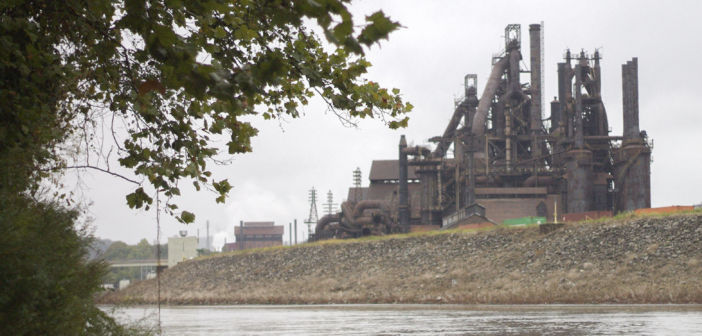Totaling 1,360 square miles in size, the Lehigh River provides the vast majority of municipalities, industries, residences and businesses in the Lehigh Valley with water each year.
Yet, despite the Lehigh River playing such an important role in the region’s water supply, the quality is nowhere where it should be, according to local environmentalists.
“In the Lehigh Valley, more than 50 percent of our streams’ miles do not meet their designated use,” said Abigail Pattishall, vice president of the Wildlands Conservancy. “If streams are supposed to be safe for recreation, fishing or drinking water, more than 50 percent does not meet that basic standard.”
Many factors are taken into account when thinking about maintaining a healthy water quality. Land use is one of the biggest reasons why there’s poor water quality in the Lehigh River.
Pattishall said one of the biggest challenges in maintaining a healthy river is the rapid development that has occurred within Lehigh and Northampton counties. What was once empty farmlands and grass is now homes and warehouses.
Pattishall said much of the land in Lehigh and Northampton counties are developed. She said in the northern part of the shed near the Poconos, there’s a lot of protected forest land, so there’s a lot of nature preserves and state forests leading to good water quality.
Pattishall said five percent of streams are impaired in the Poconos.
While the Lehigh River has pollution in its water like many other watersheds, it’s more often than not non-point source pollution, which means the source of pollution can’t be pinpointed to a single site. There can be multiple factors.
“Every time it rains, all of the pollutants that are spread over the landscape wash away and make their way to the river,” Pattishall said. “Excess nutrients being placed on agricultural landscapes and also residential landscapes is an issue.”
Pattishall said thermal pollution is one of the biggest causes of poor water quality in the Lehigh River. She said the less natural land cover and the more warehouses and roads as surfaces, the warmer the water is when it runs off, and it gets into the streams.
Dams also cause thermal pollution, which is why Pattishall and her team at Wildlands Conservancy have seen some success in the water quality since they’ve removed 40 dams in the past 10 years.
Not only is healthy water quality a benefit to the environment, but also the economy.
“Outdoor recreation generates billions of dollars for local economies,” Pattishall said. “With fishing and hunting licenses and people that are boating, kayaking, canoeing and businesses that operate with water recreation activities, there’s a huge economic benefit to us having clean water.”
Steve Chuckra, vice president of the Lehigh River Stocking Association, said the Lehigh River provides more than $17 million in economic benefits to the local area.
Chuckra said one of the problems is that a lot of people benefit economically from the river from rafting and fishing, but they don’t do anything to replenish it. He said everyone needs to be a stakeholder and do their part.
So, what’s one way humans can help improve the water quality?
Pattishall said it’s to have a riparian buffer between polluting land uses and the waterways.
“If you protect all of the streams with a wide band of vegetation, that vegetation will be able to absorb a lot of that runoff and will absorb a lot of that pollution before it makes its way into the stream,” Pattishall said. “That’s the biggest, easiest and (most) simple thing that could be done, is if we passed regulations to ensure that human activities were set back from the stream.”
While the Lehigh River only meets 50 percent of its designated standard, Chuckra said the water quality has increased in the past 20 years — by having a cooler river throughout the summer, which improves the fishery. This is important for keeping the wildlife in the watershed safe.
Mike Stanislaw, director of the Lehigh Coldwater Fishery Alliance, said trout are a cold-water species, so when the water gets warm, this hurts the fish. He said anytime the water temperature gets at or above 70 degrees, the trout start to get stressed. Stanislaw said that stress comes from a reduction in oxygen levels that the water holds.
“So as water temperatures warm, water is less able to hold oxygen within the water itself, and trout need a lot of oxygen,” Stanislaw said. “When it’s above 70 degrees, it gets less oxygen, and they start to become lethargic and won’t eat. If the water temperature gets too close to 80 degrees for any period of time —more than a day or two, they’ll start to die off.”
Not only do the fish benefit from cold water, but humans do as well.
“The downstream effects of an improved water quality benefit so much more,” Stanislaw said. “When the water is colder going into the intakes, they don’t have to treat that water as much to purify it for drinking. It makes a much better environmental process to convert that to drinking water.”
While pollution is a significant issue and has a big impact on water quality, people can start by doing little things to help improve the environment, which improves the quality of water.
“It starts with the person themselves, be careful with what you do,” Chuckra said. “If your car leaks transmission fluid or fluid oil, take care of it, because that’s going to go into a watershed one way or another.”
Pattishall said the decisions that are made that impact the environment are made at the local level — so she recommends getting in touch with local officials to advocate for improved water quality.
“I’ve seen decisions that are not good for the environment get made at municipal counting meetings at 9 p.m. on a Wednesday,” Pattishall said. “If you’re not engaged at the local level, then you’re missing the boat on trying to make a change.”






Comment policy
Comments posted to The Brown and White website are reviewed by a moderator before being approved. Incendiary speech or harassing language, including comments targeted at individuals, may be deemed unacceptable and not published. Spam and other soliciting will also be declined.
The Brown and White also reserves the right to not publish entirely anonymous comments.